Gruber Prize for DEFW
01 Jun 2011 - Marc Davis, George Efstathiou, Carlos Frenk and Simon White have won the Gruber Prize in Cosmology for their early work simulating Universes dominated by cold dark matter.
Gamma Ray Burst Distance Record
25 May 2011 - while chairing a session at the AAS meeting yesterday one the of speakers gave a well founded photometric redshift of z = 9.4 for GRB 090429B. Press conference today and paper on the arXiv submitted. News reports: USA Today, BBC, Bad Astronomy
Binary Star with a 12.75 Minute Period!
25 May 2011 - Warren Brown has found a detached binary with two white dwarf stars orbiting with a 12.75 minute period and a velocity amplitude of 1300 km/sec. This system will merge due to gravitational wave radiation in 0.9 Myr. Update 12-Jul-2011: the preprint is out.
Major New BAO Data Set
17 May 2011 - Blake et al. (2011, MNRAS accepted) report on the results of WiggleZ, which has measured the redshifts of more than 200,000 galaxies and measured the baryon acoustic scale at a redshift of z = 0.6, or 5.7 billion years before now. The measured value of the acoustic scale agrees quite well with the standard ΛCDM model and indicates that the dark energy is behaving like a cosmological constant.
Updated and Expanded Supernova Data Set
11 Apr 2011 - Conley et al. have released a catalog of 472 supernovae so I have updated my supernova cosmology page. The new dataset is quite consistent with previous supernova datasets.
New Hubble Constant
16 Mar 2011 - Riess et al. (2011, ApJ, 730, 119) report Ho = 73.8 ± 2.5 km/sec/Mpc.
z=10 Galaxy?
27 Jan 2011 - Bouwens et al. have gotten a lot of press due to a NASA press release about their candidate z=10 galaxy. While there is nothing wrong with this paper -- a z=10 galaxy would look just like this candidate -- the evidence presented is rather weak. The Hubble Space Telescope saw this object at 1.6 μm wavelength, but not at any shorter wavelengths. This could be due the Lyman α Forest absorbing all the light at wavelengths shorter than (1+z)*0.122 μm = 1.34 μm. It is important to confirm that this object emits at all wavelengths longer than 1.34 μm but the HST is unable to do this due to a design error when it was made: the mirrors are heated to room temperature. As a result the HST is not sensitive to wavelengths longer than 1.6 μm. The JWST will not repeat this error. The Spitzer Space Telescope is not sensitive enough to detect this galaxy.
Planck Early Results
11 Jan 2011 - Planck has released its Early Release Compact Source Catalog and also catalogs of compact cold cores n Milky Way molecular clouds and galaxy clusters found via the Sunyaev-Zeldovich effect. These results are designed to not include any CMB information but they are very interesting nonetheless.
Cosmic Circles[?] = Cosmic Rebirth[?]
28 Nov 2010 - There has been a lot of discussion about a preprint by Gurzadyan & Penrose entitled "Concentric circles in WMAP data may provide evidence of violent pre-Big-Bang activity". I find this very unlikely, and Peter Coles also has his doubts. It is important to remember that this is a Gurzadyan paper, and not a Penrose paper. Update 6-Dec-2010: Moss, Scott & Zibin and Wehus & Eriksen both show that Gurzadyan & Penrose made an error, and that simulated maps using the standard ΛCDM model are fully consistent with the actual WMAP data.
Allan Sandage: 1926-2010
15 Nov 2010 - Word came that Allan Sandage has died. He worked under Hubble as a student. He continued Hubble's work in determining the Hubble constant by measuring the distance and redshift of galaxies. He corrected the Hubble constant from the 500-600 km/sec/Mpc value first found by Le Maitre and Hubble to about 50 km/sec/Mpc. Sandage was then part of a controversy between the "50" camp and the "100" camp led by de Vaucouleurs, which has ultimately been settled in favor of the middle ground, with the best current value of H0=70.4±1.4 km/sec/Mpc.
WMAP: It's a wrap
19 Aug 2010 - WMAP has completed its end of mission calibration observations.
WMAP Retires
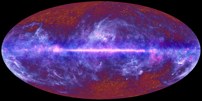 10 Aug 2010 - WMAP has stopped taking
cosmology data after nine full years of observations, with
one extra day to finish the last season of Jupiter observations.
There will be
a few days of calibration data taken at different precession angles
and then WMAP will be done.
However, observations of the CMB will continue with the Planck mission
which has more frequencies, better sensitivity, and better angular
resolution than WMAP.
10 Aug 2010 - WMAP has stopped taking
cosmology data after nine full years of observations, with
one extra day to finish the last season of Jupiter observations.
There will be
a few days of calibration data taken at different precession angles
and then WMAP will be done.
However, observations of the CMB will continue with the Planck mission
which has more frequencies, better sensitivity, and better angular
resolution than WMAP.
The thumbnail to the right is a map from Planck released in July 2010.
Click to get a larger version.
26 Jan 2010 - Geoff Burbidge, a cosmologist famous for working out how all the
elements heavier than helium are made in stars, and noted Big Bang skeptic, died
today in La Jolla. The high point of his career was the massive paper
B2FH,
"The Synthesis of the Elements in Stars".
The low point of his career was its end, devoted to promoting the
Quasi-Steady State Cosmology by
publications that verged on fraud.
Obituaries in the
LA Times, the
Wall Street Journal.
22 Jan 2010 - Andrew Lange, a principal in the
BOOMERanG experiment and
Planck, died today,
an apparent suicide.
He was very influential in pushing the development of extremely
sensitive
bolometer detectors in CMB experiments.
Update 27 Jan 2010:
New York Times obituary.
The legend that BOOMERanG showed the Universe is flat is actually not quite
correct, since the results published in 2000 had a serious
systematic error. The position of the peak
in the angular power spectrum of the
anisotropy of the CMB was known to
be ellpk = 210 ± 15 in 1999, and BOOMERanG found
ellpk = 197 ± 6 in 2000, while the correct value is
ellpk = 220. Thus while BOOMERanG provided improved precision,
it actually gave a less accurate value for the flatness of the Universe.
Since a flat Universe requires Ω=1, and Ω goes like
1/ellpk2, the 10% error in the BOOMERanG value
for ellpk really implied
a closed Universe. The
de Bernardis et al. paper correctly
claimed a flat Universe by using strong priors from non-CMB measurements.
Note that Andrew Lange also worked on the MAXIMA experiment which did not have
the systematic error, and the systematic error was corrected in 2001.
He always worked on the bleeding edge of the possible, and really extended
our capabilities in observational cosmology.
11 Nov 2009 - Fixsen
has combined velocity maps from the
WMAP satellite with the
CMB
spectra measured by the
instrument on the COBE
satellite
to come up with a quite precise value
for the To of the CMB.
FIRAS has measured the difference in total CMB power associated with
the dipole pattern to an accuracy of 1 part in 700, and since this
power varies like (v/c)To4, the well determined
velocity measured by WMAP gives a 1 part in 2000 determination of
To.
29 Oct 2009 - Today's
Nature includes the papers about the
high redshift
(z = 8) gamma-ray burst GRB090423 mentioned
earlier.
News coverage today: NPR,
USA Today, and
Universe Today,
27 Oct 2009 -
Andreon et al. (2009)
claim that the cluster JKCS041
is the most distant known cluster of galaxies.
Unfortunately they have no spectrographic
redshifts
so this distance claim must be treated with skepticism until confirmed.
17 Sep 2009 - Today's Nature
has a letter explaining the anomalous precession of the orbit of
DI Herculis
by
Albrecht et al. 2009, Nature, 461, 373.
A preprint is also available.
It turns out that the spin axes of the stars are quite mis-aligned with the
orbit, leading to tidal torques that explain why the precession
was slower than the prediction of General Relativity.
11 Sep 2009 - Bouwens et
al. (2009) have posted a preprint describing a set of 5
redshift 8 to 8.5 galaxies in the Hubble Ultra
Deep Field. My cosmology calculator
gives an age for the Universe of 625 million years for these objects.
While these are redshifts based on colors, they appear to be
reasonable. A press release is promised for when the paper is
accepted, and I expect spectacular new images of the HUDF will be
released, but for now admire the HUDF in optical
vs infrared from 2004. In 2004 the Hubble had a small IR camera,
but even so it could see distant galaxies better in the IR than in the
optical. Now it has a big IR camera in the WFC3, and can observe more
distant galaxies than before.
02 Sep 2009 -
Fomalont, Kopeikin, Lanyi & Benson report on an improved
measurement of the deflection of starlight using radio waves and the
VLBA.
The result agrees quite well with General
Relativity.
Oddly enough, the
press
coverage is dated 2 Sep 2009 although the paper was published
in the 10 July 2009 ApJ. Also odd is that there was a
press release
at all, since the
previous work using the delay
of radio signals from
Cassini
is 13 times more accurate.
But it is nice to know that the deflection of starlight, the experiment
that made Einstein famous, agrees with the prediction of General
Relativity to one part in 6000. The claim in the press release of
1 part in 30,000 accuracy is just bad arithmetic.
[Update 2-Sep-2009 19:28 PDT: I E-mailed Dave Finley at NRAO about
the arithmetic problem and he fixed it.]
01 Jul 2009 -
Jean-Loup Puget reported today that the Planck HFI was at 0.1 K
and signals are being received from the bolometers. This is similar to
the startup of WMAP, which took a slower route to L2 but did not need
to be as cold. WMAP made its
first data release 587 days after launch. Let's see if Planck can
match WMAP: 21 Dec 2010 would be that goal.
The lowest commandable 3He rate is giving good cooling so the
prospects are good for a two-year mission.
UPDATE: 17 Sep 2009 - Planck has released first
light images.
15 May 2009 - After 2090 days of cryogenic operation in space, the
Spitzer Space Telescope
has used up its entire stock
of liquid helium and is warming up. I first worked on Spitzer when it was
the Shuttle Infrared Telescope Facility in 1976.
14 May 2009 -
Herschel
and Planck
have launched! ESA has a page listing the
latest press
releases.
Herschel is a 3.5 meter diameter far-infrared telescope. The
BLAST balloon-borne large sub-millimeter telescope
was a test of one of the Herschel intruments. I first heard
about Herschel when it was called FIRST and was an 8 meter telescope,
back in the early 1980's. At that time NASA was planning to build a
a 20 meter far-infrared telescope call the Large Deployable Reflector.
In 1980 this NASA project was called
LADIRT.
Planck is a new CMB anisotropy
mission many times more sensitive than
WMAP and also covers a larger
range of frequencies with better angular resolution.
It should do very good work on small angular CMB anisotropy
and the Sunyaev-Zeldovich effect.
And the first of many planned spacewalks during the
STS-125 mission to repair the Hubble
Space Telescope is going well today.
07 May 2009 - Riess et
al. report a new value for the Hubble constant of Ho = 74.2
+/- 3.6 km/sec/Mpc based on Cepheid measurements in galaxies that have
hosted Type Ia supernovae, including
the nuclear ring maser galaxy
NGC 4258 which has a very precise distance determined by geometric
means.
28 Apr 2009 -
NASA and the CfA
issued press releases about a gamma-ray burst that went off on 23 April
2009, known as GRB 090423. The burst showed a fading infrared
transient but no flux in the optical. In fact there was no flux
shorter than 1.1 microns. If
this edge is assigned to the Lyman
α forest edge at 122 nm, then the redshift is z = 8. No paper has been
submitted to the preprint server, but a collection of GCN Circulars is
available.
Update 8 Jun 2009:
Tanvir et al.
and Salvaterra et al.
have been posted.
09 Apr 2009 - BLAST
has published results in today's Nature:
Devlin et al (Nature, 2009, 458, 737)
showing that half of the CIRB at 250 to 500
micron wavelengths comes
from redshifts
less than 1.2, and half comes from redshifts greater than
1.2. The arXiv version
includes the supplemental information. A more complete paper discussing
these results is Marsden
et al.
24 Feb 2009 - The Reid et al.
paper
describing the press announcment is
finally on the preprint server.
The value for the distance from the Sun to the Galactic Center is
8.4 +/- 0.6 kpc.
The rotational speed at this distance from the Galactic Center is
254 +/- 16 km/sec. Allowing for the 5.3 km/sec peculiar velocity of the Sun in
the direction of Galactic rotation, a predicted proper motion for the
Galactic Center of 6.50 +/- 0.20 milli-arcseconds/year is found compared to
the observed proper motion 6.379 +/- 0.024 milli-arcseconds/year.
This rotation speed is very similar to the rotation speed of Andromeda
at the same radius, implying that the Milky Way and Andromeda are very
similar in mass. This represents an increased mass for the Milky Way.
07 Jan 2009 - The ARCADE
experiment reported (
NYT,
Science News,
GSFC press release)
the existence of an extragalactic radio background.
But this signal has the same spectrum as the radio emission from the
Milky Way, and could well be due to an error in determining the
galactic contribution to the total signal. The papers are available
here,
here,
here and
here.
The ARCADE data are beautiful but mainly cover higher frequencies where
the extragalactic radio background is not detectable, so the "ERB" depends
on a debatable assumption about the lower frequency data, which are all
tied to the
Haslam 408 Mhz map, published in 1981, but with a zero point
set using
Pauliny-Toth & Shakeshaft, published in 1962!
Pauliny-Toth & Shakeshaft certainly did not see an ERB or even the CMB
in their data.
Update 26 Nov 2010: Guzman
et al. give a much smaller ERB estimate.
05 Jan 2009 - Mark Reid reported at the AAS meeting
on very precise distances to radio masers
that have led to an increase in the estimated size and rotation velocity
of the Milky Way
(NYT,
BBC).
The distance scale scale and velocity both increase
by 15 percent so the angular velocity stays about the same. This
leads to a 50 percent increase in the estimated mass of the Milky Way.
24 Sep 2008 -
Kashlinsky et al. (2008) have claimed a detection of a
bulk flow in the motion of many distant X-ray emitting clusters of galaxies.
Unfortunately this paper and the
companion paper
have several errors so their conclusions cannot be trusted.
A technical discussion of these errors can be found
here.
Geoff Burbidge, 1925-2010
Seven Year WMAP Results
 25 Jan 2010 - The seven year datasets and papers from
WMAP
are posted on LAMBDA.
Luckily for me, the default parameters in my
Cosmology Calculator taken from the
first year results are still a good fit to all the data.
The image on the right shows a map of the
anisotropy of the Cosmic Microwave Background
in the three highest frequency bands measured by WMAP: 41, 61 and 94 GHz.
Click on the thumbnail for a larger version.
25 Jan 2010 - The seven year datasets and papers from
WMAP
are posted on LAMBDA.
Luckily for me, the default parameters in my
Cosmology Calculator taken from the
first year results are still a good fit to all the data.
The image on the right shows a map of the
anisotropy of the Cosmic Microwave Background
in the three highest frequency bands measured by WMAP: 41, 61 and 94 GHz.
Click on the thumbnail for a larger version.
A Sad Loss
New determination of TCMB
Most Distant Object
Most Distant Cluster?
General Relativity Wins Again
MIT Press Release.
The Cat Herder.
Redshift 8 Galaxies in Infrared
Improved Test of General Relativity
Planck is cold and getting signals
Spitzer Warming Up
Big Day for Space-Based Astronomy: Planck, Herschel, Hubble
More Accurate Hubble Constant
Highest Redshift GRB Seen
BLAST Results on the Far Infrared Background
More Bigger Milky Way
An Extragalactic Radio Background?
A Bigger Milky Way
Dark Flow Detected - Not!
Meet the
Fermi Gamma-ray Space Telescope

26 Aug 2008 -
NASA
released an all sky map
in gamma rays
from the satellite formerly known as GLAST, newly renamed as
the Fermi Gamma-ray Space Telescope or FGST.
Enrico Fermi discovered the Fermi-Dirac statistics followed by
particles known as fermions, such as electrons and protons,
emigrated to America to escape fascism, and built the first
nuclear reactor as part of the Manhattan Project.
FGST will have greatly improved angular resolution and sensitivity for
high energy gamma rays with E > 1 GeV at the short wavelength
end of the electromagnetic spectrum, and
should discover thousands of
gamma ray sources at cosmological distances.
Variable Constants?
20 Jun 2008 - Murphy, Flambaum, Muller & Henkel (2008) show that the ratio of the proton mass to the electron mass has varied by less than 1.8 parts per million (95% CL) since redshift z = 0.68466. They compared the radio inversion lines of ammonia to the pure rotation lines of HCN and HCO+. All of these lines are measured very precisely using radio astronomy techniques, and the redshifts are consistent. But the ammonia lines are much more sensitive to the proton:electron mass ratio so this quantity has not varied in the past 6 billion years. This report is an improvement over previous results using the same quasar absorption line cloud.
Another Bullet Cluster
17 Jun 2008 - Bradac et al. (2008) have found another bullet cluster where two clusters of galaxies have collided, leaving the hot gas in between the clumps of galaxies, but the source of gravity has passed right through the collision, staying with the galaxies. Since the hot gas is most of the normal matter, this shows that the source of gravity is not the normal matter, but rather dark matter. This is a problem for alternative models that modify gravity to eliminate the need for dark matter.
Supernova Initial Flash
22 May 2008 - Soderberg et al. report an observation of a soft X-ray flare from a spot that later turned out to be a Type Ibc supernova. The peak flux was about 7 x 10-10 erg/cm2/sec for about 400 seconds. At the 27 Mpc distance of the host galaxy NGC 2770 this is about 2 x 1046 ergs in X-rays produced when the shockwave breaks out of the massive star whose core has collapsed. The UV peaked a day later, and the optical 20 days later as the remains of the star expanded and cooled.
This was quite an interesting result when it appeared three months ago on arxiv.org, but it was embargoed by Nature until publication so I didn't post this news item until now.
New High Redshift CMB Measurement
13 May 2008 - Srianand et al. have announced a measurement of TCMB at a redshift of 2.418. Absorption lines from carbon monoxide (CO) molecules were seen in the spectrum of a distant quasar, and showed rotational excitation in the CO ground vibrational state. The temperature seen is 9.15 +/- 0.7 K, while the Big Bang model predicts 9.315 K. So this observation is consistent with the Big Bang, but contradicts the Steady State model.
New Union Supernova Catalog
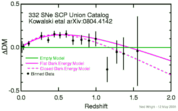 28 Apr 2008 -
Kowalski et al. (2008)
of the Supernova Cosmology Project present a union catalog of supernovae.
The catalog contains 332 SNe that pass all cuts when the low
redshift SNe
are included. Click on the thumbnail at right for binned ΔDM
vs. redshift tables and plots.
ΔDM is the difference in the
distance modulus between the data or model and an empty Universe
model. A higher distance modulus means the supernovae are fainter
than expected in an empty Universe.
28 Apr 2008 -
Kowalski et al. (2008)
of the Supernova Cosmology Project present a union catalog of supernovae.
The catalog contains 332 SNe that pass all cuts when the low
redshift SNe
are included. Click on the thumbnail at right for binned ΔDM
vs. redshift tables and plots.
ΔDM is the difference in the
distance modulus between the data or model and an empty Universe
model. A higher distance modulus means the supernovae are fainter
than expected in an empty Universe.
Tired Light is Still Dead
24 Apr 2008 - Blondin et al. (2008) studied distant supernovae using spectra to judge the age of the object during each observation. They found an aging rate that varied with redshift z like
1/(1+z)(0.97 +/- 0.10),compatible with the expected 1/(1+z) for expanding Universes, but 9.7 standard deviations away from the constant aging rate expected in the tired light model.
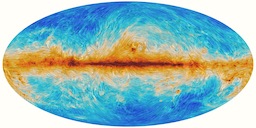
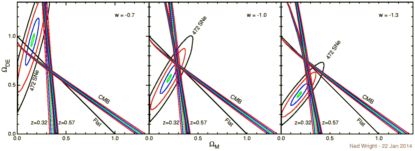

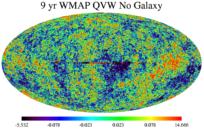

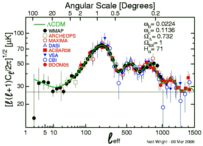

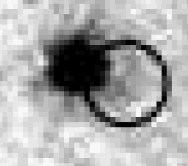 12 Jul 07 -
12 Jul 07 -
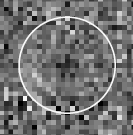 have been magnified by the
have been magnified by the
 09 Jun 2007 -
Today I visited the
09 Jun 2007 -
Today I visited the 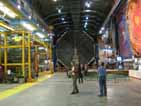 In the physics lab the lights and air handling system let you forget
you are so deep underground, and you find the
In the physics lab the lights and air handling system let you forget
you are so deep underground, and you find the
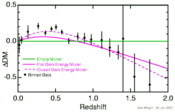
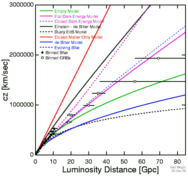
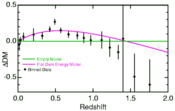
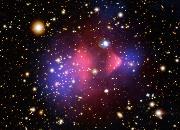
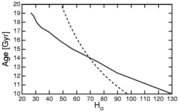
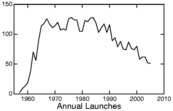
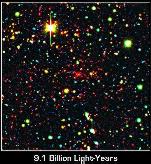
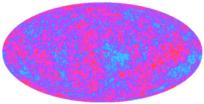 16 Mar 2006 - The
16 Mar 2006 - The 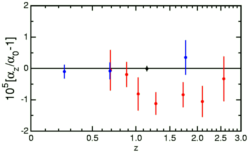
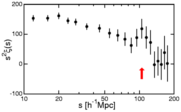

 9 Oct 2003 -
9 Oct 2003 - 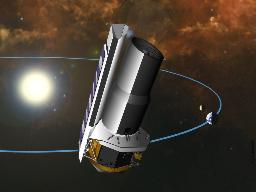

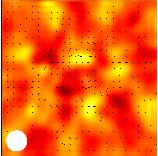
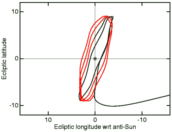
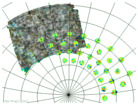
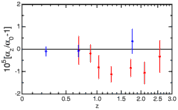
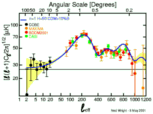
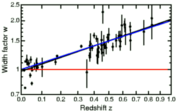
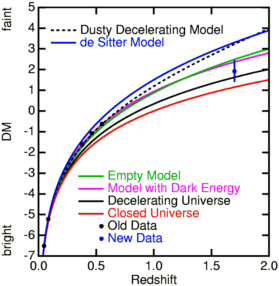
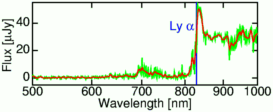
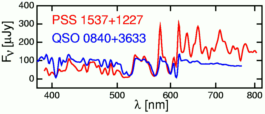

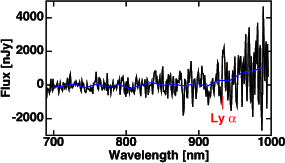 15 Apr 99 -
15 Apr 99 - 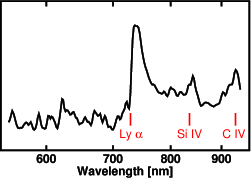 11 Dec 98 -
The
11 Dec 98 -
The